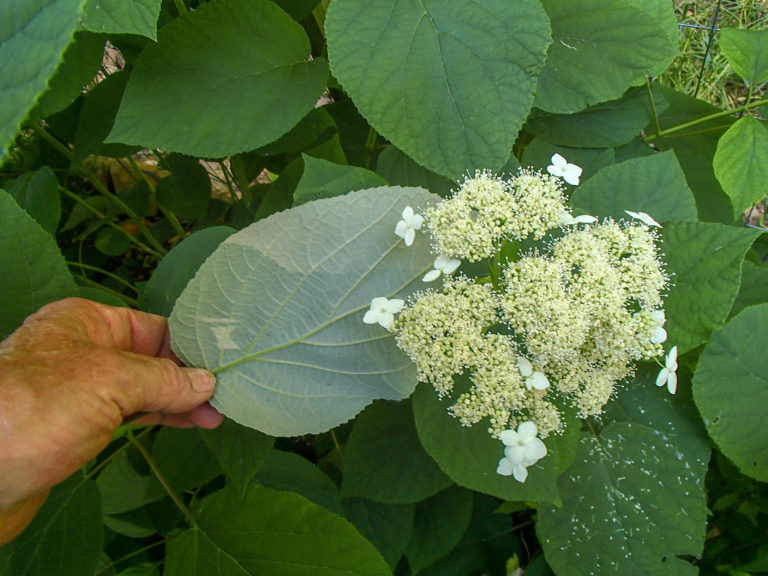Until recently, Hydrangea radiata was considered a subscpecies of Hydrangea arborescens, and they are very similar. Both are fast-growing and short-lived woody shrubs 3-6 feet high and wide. Both present a rounded form, with many, scarcely branched, twisting stems, shreddy bark, and white, flat-topped floral assemblages called corymbs, 3-6 inches across, of both sterile and fertile florets. Unlike “mophead” Hydrangeas which have only the open, sterile, petaled flowers, both of these species support a wide range of pollinator insects. Both grow well in part shade, in medium-moisture, organic, well drained, acid soil conditions. They are often treated like herbaceous perennials in the garden because, since they set flower buds on new, woody growth each year, they profit from semi-hard pruning sometime before spring, similar to a perennial. Against these similarities with H. arborescens, H. radiata stands out because of the bright white/silver underside of its leaves, which show up whenever a breeze blows, and because its flowers have more of the open, petaled florets on the perimeter of the corymb, making a showier show! Whereas H. arborescens is found in forests and roadside seeps from southern New York to the panhandle of Florida, and west to eastern Oklahoma and southeastern Kansas, H. radiata is found in a relatively small area near the junction of western North Carolina, South Carolina, Tennessee and Georgia. This plant is much loved for sparking up the shady edge of the woods with its elegant white flowers at a time in the summer when not much there is flowering. Unlike some of their Asian cousins, the color of these Hydrangeas is not affected by pH or the presence of Aluminum in the soil but is reliably sparkly white.
NURSERY HOURS
Wednesday: 10-4 Thursday: 10-6 Friday-Saturday: 10-4 Sunday: 12-4
Hydrangea radiata

Key Info
Scientific Name: Hydrangea radiata Walter
Common Names: Smooth Hydrangea, Wild Hydrangea, Sevenbark, Silver Leaf Hydrangea, Snowy Hydrangea
Family Names: Hydrangeaceae (Hydrangea Family)
Plant Type: Tree / Shrub
Moisture Requirement: Moist well drained
Leaf Retention: Deciduous
Flower Color: White
Special Characteristics: Tolerates Black Walnut, Ornamental foliage, Attracts bees, Attracts butterflies, Fast growing, Tolerates shade
Additional Info
Habit: Small, 3 to 6 feet tall, open shrub with a rounded crown and many unbranched stems with shreddy bark ("Sevenbark"), generally wider than tall, spreads into colonies by stolons..
Height: 3'-6'
Spread: 3'-6'
Soil Conditions: Moist, organic, well drained; acidic to neutral soil; sandy loamy, clay
Leaves: Opposite, simple, serrated margin, heart-shaped, 4 to 10 inches long, sometimes lobed; upper surface dark green, with hairs along the veins; lower surface silvery-white, "densely floccose-velutinous" (Weakley; meaning with a soft and woolly covering of hairs; soft and velvety), with trichomes dense enough to entirely mask the green leaf surface.
Flowers (or reproductive structures: Flat-topped, terminal, round, white or cream-colored clusters (corymbs) 4 to 6 inches across, appear in early summer, May to July. Tiny, fertile florets occupy the center; from 5-15 larger, sterile flowers with tepals bloom around the margin, making a lacecap effect. Scattered flowering may continue throughout summer to September.
Fruit: Dry, light brown, ribbed, dehiscent seed capsules appearing in early fall, October-November.
Natural Distribution: Dense woods, rocky slopes, moist soils under a hardwood forest canopy; often common along woodland road banks and streams.
USDA Hardiness Zone: 3 to 9
USDA Wetland Indicator Status in NC: FACU
Pollination: Bees, butterflies, and other insects
Wildlife Connections: Attracts bees, ants, beetles, flies and butterflies, especially Eastern Tiger Swallowtail; host for the larvae and nectar plant for the adult Hydrangea Sphinx Moth.
Propagation: By cuttings.
